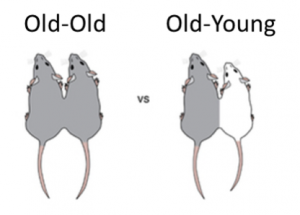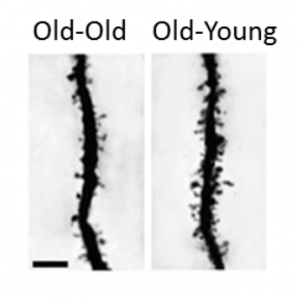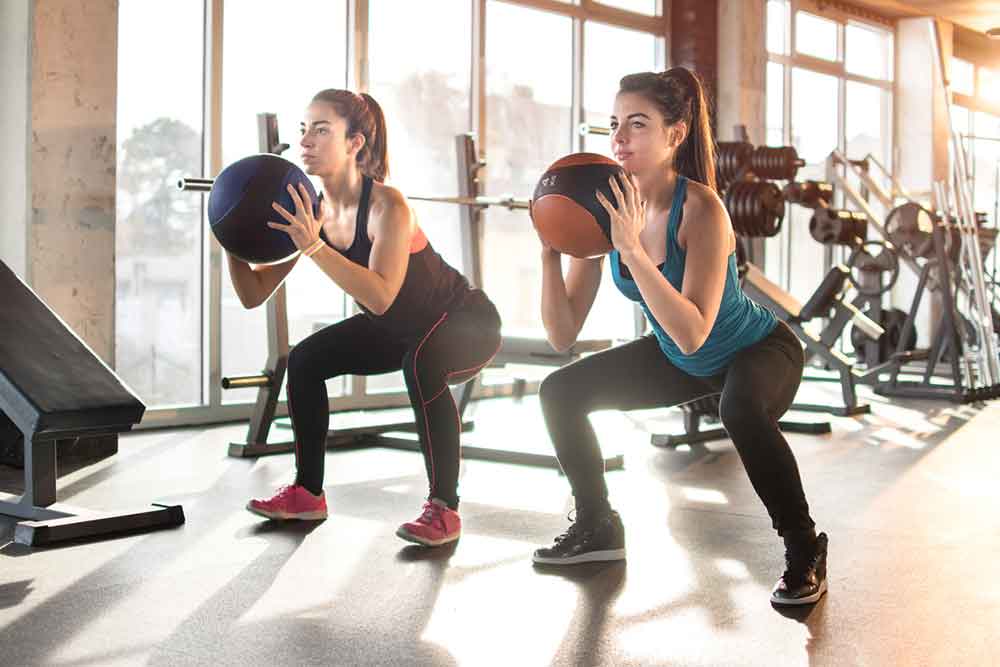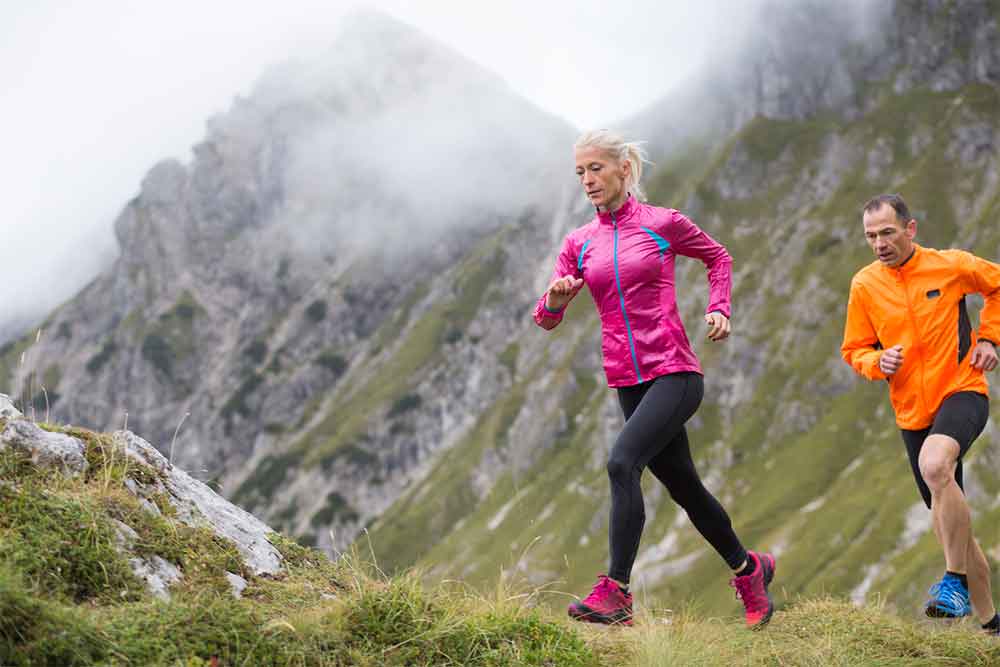Lengthen Healthspan Through Exercise

Julia Basso – PhD
Youth is a sought after thing.
Doctors, scientists, and many others among us are actively seeking the elusive fountain of youth. The ultimate question is: how do we keep our bodies and minds young? One of my favorite movies, Death Becomes Her, stars Meryl Streep and Goldie Hawn. In it, these middle-aged women take a potion that reverses the aging process and makes them immortal – something that does not turn out well for them in the end. But, is there a magic potion like this out there? Can we take something or do something that would take years off our life?
The Research
In a scientific paper published about two years ago, scientists at Stanford University and the University of California San Francisco conducted a radical project to answer this question.
 First, as shown in this picture, they connected the circulatory system of two mice so that their blood was shared (Villeda et al., 2014). In the control condition, two old mice were connected. In the experimental condition, an old mouse was connected to a young mouse – that is, the old mouse now received young mouse blood. The scientists then examined the brain and behavior of the old mouse.
First, as shown in this picture, they connected the circulatory system of two mice so that their blood was shared (Villeda et al., 2014). In the control condition, two old mice were connected. In the experimental condition, an old mouse was connected to a young mouse – that is, the old mouse now received young mouse blood. The scientists then examined the brain and behavior of the old mouse.
Could young mouse blood make the old mouse look like new?
The Hippocampus
They examined an area of the brain that I talk about often and is particularly sensitive to the aging process – the hippocampus. This part of the brain supports our ability to learn and remember information. As we age, the hippocampus shrinks and loses its capacity to function as it did before. This is one of the reasons why older individuals suffer from cognitive impairment. So, what happened to the hippocampus of the old mouse that was now connected to the young mouse? It became young!
 A brain cell or neuron is composed of several parts. For example, long, arm-like branches on neurons are called dendrites. The dendrites are covered in formations called spines that then join together with spines on other neurons. This connection between two neurons is a synapse.
A brain cell or neuron is composed of several parts. For example, long, arm-like branches on neurons are called dendrites. The dendrites are covered in formations called spines that then join together with spines on other neurons. This connection between two neurons is a synapse.
As we age, the number of spines on our dendrites decreases; thus, the number of connections between neurons decreases. By connecting the old mouse to the young mouse, the number of spines on the dendrites significantly increased so that the dendrites now looked young.
Young By Association
When the scientists recorded these neurons to test how they functioned or fired, they now acted like young neurons. The brain looked and acted younger, but how did this translate to how the rodents behaved? As you might guess, the old mice connected to the young mice now had an enhanced ability to learn and remember information. In essence, the young blood acted like the magical fountain of youth, causing the old mice to act younger.
Next, the scientists wanted to know exactly what factor in the young blood was making the old mice young again. After many technical procedures, they boiled it down to a factor known as CREB (cAMP response element-binding protein). CREB is a protein that binds to DNA and helps to either turn on or off genes. Interestingly, the genes that it is regulates are involved in brain changes related to long-term memory and neurodegenerative diseases like Alzheimer’s disease.
Related Article: Exercise, Fitness, And Alzheimer’s Disease
Exercise
While reading this paper, I was reminded of something I read about everyday – exercise. Exercise causes all of these same changes:
-
Increased numbers of spines
-
Enhanced functioning of neurons
-
Improvements in learning and memory
So I thought…does exercise cause increases in CREB signaling as well?
CREB Signaling
As I predicted, exercise increases production of CREB in the brain.
Only 10 days of voluntary wheel running in mice activated CREB in both the cortex and hippocampus of mice (Yang et al., 2014). Additionally, the increases in CREB production may be related to the ability of exercise to stimulate the sympathetic nervous system (Bruno et al., 2014). That is, adrenaline and noradrenaline produced during exercise appear to cause the increased CREB activity.
The process of exercise-induced CREB stimulation then causes increases in proteins like brain derived neurotrophic factor (Chen & Russo-Neustadt, 2009), which help to enhance the brain’s ability to learn and remember.
Takeaway
Collectively, this research tells an exciting story.
-
Scientists identified a factor in our blood that makes us younger: CREB
-
Exercise has the ability to increase CREB
Therefore, exercising can actually make us younger!
The fountain of youth may not be so elusive after all. All we have to do is exercise.
Related Article: A Fun Alternative: Trampoline Workouts
(adsbygoogle = window.adsbygoogle || []).push({});
You Might Like:
Keep Moving – Aerobic Exercise Increases College GPAs
Julia C. Basso, PhD Reporting from the 2017 Annual Society for Neuroscience Meeting (Basso JC, Crosta C, Raskin M, Wang A, Kadakia D, Choi J, Milburn E, Trivedi R, Suzuki WA) Long-term aerobic exercise enhances mood...Exercise May Improve Brain Health In Adolescent Binge Drinking
Julia C. Basso, PhD Reporting from the 2017 Annual Society for Neuroscience Meeting Exercise highlight 5: Voluntary exercise restores adolescent binge ethanol-induced loss of basal forebrain cholinergic neurons in adulthood (RP Vetreno, FT Crews) The...Sense & Movement – A Surprisingly Unique Phenomenon
Julia C. Basso, PhD Reporting from the 2017 Annual Society for Neuroscience Meeting The ability to adapt your movement to signals or cues in the environment is known as sensorimotor adaptation, the focus of one...Learning, Memory, & Decision Making
Julia C. Basso, PhD Reporting from the 2017 Annual Society for Neuroscience Meeting Making good decisions requires memory. Take for example, the hangover (maybe that some of us are experiencing today after the reunion with...What Factors Determine Ultra-Marathon Success?
Julia C. Basso, PhD 100 miles is approximately the distance from the surface of the earth to the planet’s boundary, called suborbital space. This is also the distance run by ultra-marathon racers. To be considered...Exercise & Celiac Disease
Julia C. Basso, PhD Eating gluten free seems to be in fashion at the moment. You can find gluten free foods at almost every super market these days. However, for some gluten free is not...References:
Bruno, N. E., Kelly, K. A., Hawkins, R., Bramah‐Lawani, M., Amelio, A. L., Nwachukwu, J. C., … & Conkright, M. D. (2014). Creb coactivators direct anabolic responses and enhance performance of skeletal muscle. The EMBO journal, 33(9), 1027-1043.
Chen, M. J., & Russo‐Neustadt, A. A. (2009). Running exercise‐induced up‐regulation of hippocampal brain‐derived neurotrophic factor is CREB‐dependent. Hippocampus, 19(10), 962-972.
Villeda, S. A., Plambeck, K. E., Middeldorp, J., Castellano, J. M., Mosher, K. I., Luo, J., … & Wabl, R. (2014). Young blood reverses age-related impairments in cognitive function and synaptic plasticity in mice. Nature medicine, 20(6), 659-663.
Yang, J. L., Lin, Y. T., Chuang, P. C., Bohr, V. A., & Mattson, M. P. (2014). BDNF and exercise enhance neuronal DNA repair by stimulating CREB-mediated production of apurinic/apyrimidinic endonuclease 1.Neuromolecular medicine, 16(1), 161-174.
(adsbygoogle = window.adsbygoogle || []).push({});
















